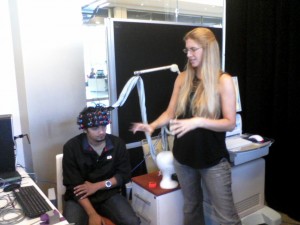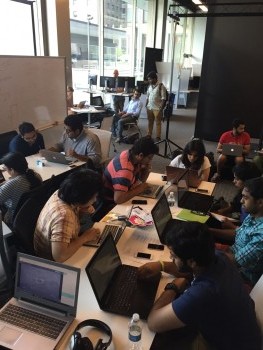(Editor’s Note: This post was written by Sarah Bratt, a recent graduate of the master’s degree program in Library and Information Science at the School of Information Studies at Syracuse University. She’s now working at the SU M.I.N.D. lab.)
P.S. – If you’re interested in the lab, there’s an open event on Thursday, July 9 from 9 a.m. to 3 p.m. at 100 Madison Ave., Syracuse, to learn about current research efforts. You’re welcome to attend and join in the activities!)
__________________________________________________________________________________
Here’s a perfect partnership: brain data, applied summer research, and iSchool internships.
They’ve come together this summer, as the research team at the Media interface Network Design (MIND) lab put a call out for interns. Nevertheless, our team at Syracuse University was not expecting 65 responses from students of all degree levels. And, boy, we’ve got brain power this summer!
Our recruitment call for interns was a match made in pedagogical heaven, where we aim to unify theory and
practice. Those in the study group are largely Syracuse University School of Information Studies students interested in cybersecurity, machine learning, and the practical application of their data science curriculum. Most of the student interns are pursuing a master’s degree in information management as students at the School of Information Studies, or at EE&CS, with a handful of them being undergraduates.
The M.I.N.D. Lab
The Media, Interface and Network Design (M.I.N.D.) Lab is an international network of human computer interaction labs specializing in virtual environment design and media research. The facility is a unique combination of the arts, new media and scientific human-computer interaction, allowing for research that supports visual and performing arts with virtual environment tools, according to Syracuse University.
The M.I.N.D. lab is located in the AXA building near the Tech Garden on Harrison Street downtown. The lab is equipped with Hitchai fNIRS and various immersive virtual reality technologies for running experiments measuring brain activity.
Our Research
M.I.N.D. research began with a day of projects, with Leanne Hirshfield, institutional researcher, presenting to more than 40 students for “wave #1.”
Research involves designing HCI interfaces, human-automation interaction (e.g. Army helicopter systems), and understanding trust and suspicion in the brain, among other topics. However, the lab was a big place with need for creative energy. While researchers at the lab work with a group of undergraduate CS majors at Hamilton College (in Clinton, NY), who spend eight weeks every summer learning to implement python code on projects, we never had the opportunity to work with a group at Syracuse to experience research.
 M.I.N.D. Internships: Mutual Benefit
M.I.N.D. Internships: Mutual Benefit
As it turns out, the student interns are inquisitive, diligent, and hungry to use real data. They have the perfect mix of skills and thirst for new knowledge to try out Orient DB and Orange, a data mining tool for conducting supervised and unsupervised machine learning.
We recently ran a neuro-marketing advertisement experiment and taught students about data collection and the steps involved in participant preparation, debriefing, and high-dimensional data analysis.
Six Projects
We’re working on six different projects:
1) Data Collection support
Three experiments will be run this summer. They already have been designed and successfully implemented. The experiments are called “workload/emotion experiment,” “advertising/emotion experiment,” and “suspicion experiment.” Four to six students are being trained on the fNIRS and added to the IRB protocol. These students will support staff members throughout the summer to run 30 subjects total.
2) Data Management Support
We have many large datasets, and we need help organizing the datasets and getting them set up in a research box. As of now, these data sets exist on local PCs and must be standardized and described. The first wave of interns created an ERD and the students are now working on implementing a MYSQL and noSQL graph database in Orient DB. A file hierarchy was created for data storage, and a research box was drafted.
3) Machine Learning in Python/R
This is related to item 2) above. This project will involve creating python/r code to work with the fNIRS datasets on the research box. Staff members are guiding student(s) to create a Python program to take data from any the fNIRS device, to extract features and run machine learning, basic statistics, and do basic graph generation, on the data.
4) Statistics Support
We have several past survey datasets that need to be statistically evaluated. These include the “workload/emotion” and “advertising/emotion” experiments described above. Also, when new data is collected this summer, statistics will need to be run on that data as well. We will create conditions files, working in tandem with the Machine Learning team.
5) An Army Helicopter project involving interviewing helicopter pilots to understand how they currently interact with their helicopter interfaces, and how they currently perceive and interpret various types of damage to the helicopter parts
6) Text mining and NLP, working with an existing dataset from IM conversations between individuals while they worked on a teamwork scenario. Feature extraction is needed to identify textual patterns for predicting trust in one’s partner and emotional state during conversations. NLP work will be done primarily in python (or another language, if the student has experience).
Future work and partnerships
Weekly reports from the team allow a self-reflective synthesis of their work, and an iterative learning process. The internships will continue into the fall of 2015 for students with continued interest in MIND lab research.
Future prospects for the student-MIND lab partnership include increased applied machine learning, CS, and information management and publications submitted to venues such as Human Computer Interaction International 2016 with continued effort produces publication-worthy results.
Have you got thoughts or comments about this initiative. Please leave your comments and questions here!

